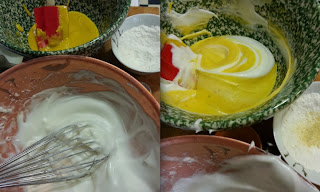I made a parsnip pie back in 2007, and here's a new version.
Crust:
- 8 oz. flour
- 4 oz. lard
- 1½ oz butter
- ⅓ c. water
- ½ tsp salt
Filling:
- 18 oz. parsnips
- chicken stock
- butter
- allspice berries
- thyme
- 8 oz. crème fraîche
- 4 eggs, separated
- nutmeg, grated (I used about an ⅛ of an inch nutmeg)
- salt, pepper
Make the crust as you would any other (that's modified from Tartine's recipe), or use your favorite recipe. The lard seemed like a good idea for Thanksgiving. Chill overnight or at least while preparing the parsnips.
Chop and roast the parsnips at 375ºF with some allspice, thyme, and a few knobs of butter, with a half inch of chicken stock in the pan.

Meanwhile, roll out your crust, bake for ten minutes (also at 375ºF) with foil and pie weights and another eight without, until it is fully baked.
When the stock has evaporated form the parsnips, replenish, and roast until they are soft and caramelized (about an hour).
Purée the parsnips, adding enough stock to make it smooth. Pass this through a conical strainer (chinois), food mill, or sieve, so that the allspice and any fibers are taken out.
Add egg yolks one at a time, then fold in crème fraîche and season with salt, pepper, nutmeg, and more thyme. Beat the whites to soft peaks and whisk into the parsnip mix (you don't need to be gentle—it's not a soufflé, it's okay to beat to get it smooth).
Pour into the prebaked shell and bake for about 45 minutes at 325ºF, until set.
And here it is:




















